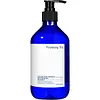What's inside
What's inside
 Key Ingredients
Key Ingredients

 Benefits
Benefits

 Concerns
Concerns

 Ingredients Side-by-side
Ingredients Side-by-side

Water
Skin ConditioningSodium Methyl Cocoyl Taurate
CleansingSodium C14-16 Olefin Sulfonate
CleansingLauryl Betaine
CleansingSodium Chloride
MaskingDecyl Glucoside
CleansingParfum
MaskingLauryl Hydroxysultaine
CleansingChamaecyparis Obtusa Water
MaskingLauryl Glucoside
CleansingXylitylglucoside
HumectantPolyquaternium-7
Anhydroxylitol
HumectantPPG-3 Caprylyl Ether
SolventPolyquaternium-47
Skin ConditioningPotassium Benzoate
PreservativeCitric Acid
BufferingXylitol
HumectantSaccharide Isomerate
HumectantCeramide AP
Skin Conditioning1,2-Hexanediol
Skin ConditioningSodium Benzoate
MaskingBiotin
AntiseborrhoeicCeramide NP
Skin ConditioningHydroxypropyltrimonium Hyaluronate
Sodium Citrate
BufferingSqualane
EmollientButylene Glycol
HumectantPentylene Glycol
Skin ConditioningCaprylyl Glycol
EmollientHydrolyzed Soy Protein
HumectantGlycoproteins
Skin ConditioningOligopeptide-2
Skin ConditioningWater, Sodium Methyl Cocoyl Taurate, Sodium C14-16 Olefin Sulfonate, Lauryl Betaine, Sodium Chloride, Decyl Glucoside, Parfum, Lauryl Hydroxysultaine, Chamaecyparis Obtusa Water, Lauryl Glucoside, Xylitylglucoside, Polyquaternium-7, Anhydroxylitol, PPG-3 Caprylyl Ether, Polyquaternium-47, Potassium Benzoate, Citric Acid, Xylitol, Saccharide Isomerate, Ceramide AP, 1,2-Hexanediol, Sodium Benzoate, Biotin, Ceramide NP, Hydroxypropyltrimonium Hyaluronate, Sodium Citrate, Squalane, Butylene Glycol, Pentylene Glycol, Caprylyl Glycol, Hydrolyzed Soy Protein, Glycoproteins, Oligopeptide-2
Water
Skin ConditioningCoco-Betaine
CleansingSodium Surfactin
CleansingSodium Cocoyl Alaninate
Lauryl Glucoside
CleansingDisodium Laureth Sulfosuccinate
CleansingGlycerin
HumectantSodium Chloride
MaskingSodium Lauroyl Methyl Isethionate
CleansingCaprylyl Glycol
EmollientCetyl Alcohol
EmollientHydroxyacetophenone
AntioxidantPolyquaternium-10
Citric Acid
BufferingMenthol
MaskingGuar Hydroxypropyltrimonium Chloride
Skin ConditioningMelaleuca Alternifolia Leaf Oil
AntioxidantPentasodium Pentetate
Citrus Paradisi Peel Oil
MaskingButylene Glycol
HumectantAcorus Calamus Root Extract
PerfumingAllium Cepa Bulb Extract
Skin ConditioningArtemisia Capillaris Extract
Brassica Oleracea Italica Extract
Astringent1,2-Hexanediol
Skin ConditioningCnidium Officinale Root Extract
Skin ConditioningHouttuynia Cordata Extract
Skin ConditioningCysteine
AntioxidantMethionine
Skin ConditioningMelaleuca Alternifolia Leaf Extract
PerfumingSalvia Officinalis Leaf Extract
CleansingCamellia Japonica Flower Extract
EmollientZingiber Officinale Root Extract
MaskingEthylhexylglycerin
Skin ConditioningWater, Coco-Betaine, Sodium Surfactin, Sodium Cocoyl Alaninate, Lauryl Glucoside, Disodium Laureth Sulfosuccinate, Glycerin, Sodium Chloride, Sodium Lauroyl Methyl Isethionate, Caprylyl Glycol, Cetyl Alcohol, Hydroxyacetophenone, Polyquaternium-10, Citric Acid, Menthol, Guar Hydroxypropyltrimonium Chloride, Melaleuca Alternifolia Leaf Oil, Pentasodium Pentetate, Citrus Paradisi Peel Oil, Butylene Glycol, Acorus Calamus Root Extract, Allium Cepa Bulb Extract, Artemisia Capillaris Extract, Brassica Oleracea Italica Extract, 1,2-Hexanediol, Cnidium Officinale Root Extract, Houttuynia Cordata Extract, Cysteine, Methionine, Melaleuca Alternifolia Leaf Extract, Salvia Officinalis Leaf Extract, Camellia Japonica Flower Extract, Zingiber Officinale Root Extract, Ethylhexylglycerin
Ingredients Explained
These ingredients are found in both products.
Ingredients higher up in an ingredient list are typically present in a larger amount.
1,2-Hexanediol is a synthetic liquid and another multi-functional powerhouse.
It is a:
- Humectant, drawing moisture into the skin
- Emollient, helping to soften skin
- Solvent, dispersing and stabilizing formulas
- Preservative booster, enhancing the antimicrobial activity of other preservatives
Butylene Glycol (or BG) is used within cosmetic products for a few different reasons:
Overall, Butylene Glycol is a safe and well-rounded ingredient that works well with other ingredients.
Though this ingredient works well with most skin types, some people with sensitive skin may experience a reaction such as allergic rashes, closed comedones, or itchiness.
Learn more about Butylene GlycolCaprylyl Glycol is a humectant and emollient, meaning it attracts and preserves moisture.
It is a common ingredient in many products, especially those designed to hydrate skin. The primary benefits are retaining moisture, skin softening, and promoting a healthy skin barrier.
Though Caprylyl Glycol is an alcohol derived from fatty acids, it is not the kind that can dry out skin.
This ingredient is also used as a preservative to extend the life of products. It has slight antimicrobial properties.
Learn more about Caprylyl GlycolCitric Acid is an alpha hydroxy acid (AHA) naturally found in citrus fruits like oranges, lemons, and limes.
Like other AHAs, citric acid can exfoliate skin by breaking down the bonds that hold dead skin cells together. This helps reveal smoother and brighter skin underneath.
However, this exfoliating effect only happens at high concentrations (20%) which can be hard to find in cosmetic products.
Due to this, citric acid is usually included in small amounts as a pH adjuster. This helps keep products slightly more acidic and compatible with skin's natural pH.
In skincare formulas, citric acid can:
While it can provide some skin benefits, research shows lactic acid and glycolic acid are generally more effective and less irritating exfoliants.
Most citric acid used in skincare today is made by fermenting sugars (usually from molasses). This synthetic version is identical to the natural citrus form but easier to stabilize and use in formulations.
Read more about some other popular AHA's here:
Learn more about Citric AcidLauryl Glucoside sugar- and lipid-based cleansing agent. It is created from glucose and lauryl alcohol.
This ingredient is a surfactant, making it easier to rinse oil, dirt, and other pollutants away.
A British study found lauryl glucoside to cause skin sensitivity for some people. We recommend speaking with a professional if you have concerns.
Other names for this ingredient include "Lauryl Polyglucose", "Lauryl glycoside", and "D-Glucopyranoside".
Learn more about Lauryl GlucosideChances are, you eat sodium chloride every day. Sodium Chloride is also known as table salt.
This ingredient has many purposes in skincare: thickener, emulsifier, and exfoliator.
You'll most likely find this ingredient in cleansers where it is used to create a gel-like texture. As an emulsifier, it also prevents ingredients from separating.
There is much debate on whether this ingredient is comedogenic. The short answer - comedogenic ratings don't tell the whole story. Learn more about comegodenic ratings here.
The concensus about this ingredient causing acne seems to be divided. Research is needed to understand if this ingredient does cause acne.
Scrubs may use salt as the primary exfoliating ingredient.
Learn more about Sodium ChlorideWater. It's the most common cosmetic ingredient of all. You'll usually see it at the top of ingredient lists, meaning that it makes up the largest part of the product.
So why is it so popular? Water most often acts as a solvent - this means that it helps dissolve other ingredients into the formulation.
You'll also recognize water as that liquid we all need to stay alive. If you see this, drink a glass of water. Stay hydrated!
Learn more about Water